Order-8-3 triangular honeycomb
| Order-8-3 triangular honeycomb | |
|---|---|
| Type | Regular honeycomb |
| Schläfli symbols | {3,8,3} |
| Coxeter diagrams | Error creating thumbnail: Unable to save thumbnail to destination Error creating thumbnail: Unable to save thumbnail to destination Error creating thumbnail: Unable to save thumbnail to destination Error creating thumbnail: Unable to save thumbnail to destination Error creating thumbnail: Unable to save thumbnail to destination Error creating thumbnail: Unable to save thumbnail to destination Error creating thumbnail: Unable to save thumbnail to destination
|
| Cells | {3,8} |
| Faces | {3} |
| Edge figure | {3} |
| Vertex figure | {8,3} 
|
| Dual | Self-dual |
| Coxeter group | [3,8,3] |
| Properties | Regular |
In the geometry of hyperbolic 3-space, the order-8-3 triangular honeycomb (or 3,8,3 honeycomb) is a regular space-filling tessellation (or honeycomb) with Schläfli symbol {3,8,3}.
Geometry
It has three order-8 triangular tiling {3,8} around each edge. All vertices are ultra-ideal (existing beyond the ideal boundary) with infinitely many triangular tilings existing around each vertex in an octagonal tiling vertex figure.
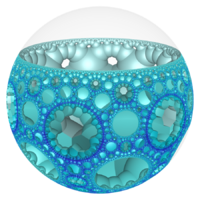 Poincaré disk model |
Related polytopes and honeycombs
It is a part of a sequence of regular honeycombs with order-8 triangular tiling cells: {3,8,p}.
It is a part of a sequence of regular honeycombs with octagonal tiling vertex figures: {p,8,3}.
It is a part of a sequence of self-dual regular honeycombs: {p,8,p}.
Order-8-4 triangular honeycomb
| Order-8-4 triangular honeycomb | |
|---|---|
| Type | Regular honeycomb |
| Schläfli symbols | {3,8,4} |
| Coxeter diagrams | Error creating thumbnail: Unable to save thumbnail to destination Error creating thumbnail: Unable to save thumbnail to destination Error creating thumbnail: Unable to save thumbnail to destination Error creating thumbnail: Unable to save thumbnail to destination Error creating thumbnail: Unable to save thumbnail to destination Error creating thumbnail: Unable to save thumbnail to destination Error creating thumbnail: Unable to save thumbnail to destination Error creating thumbnail: Unable to save thumbnail to destination Error creating thumbnail: Unable to save thumbnail to destination Error creating thumbnail: Unable to save thumbnail to destination Error creating thumbnail: Unable to save thumbnail to destination Error creating thumbnail: Unable to save thumbnail to destination Error creating thumbnail: Unable to save thumbnail to destination Error creating thumbnail: Unable to save thumbnail to destination = Error creating thumbnail: Unable to save thumbnail to destination Error creating thumbnail: Unable to save thumbnail to destination Error creating thumbnail: Unable to save thumbnail to destination Error creating thumbnail: Unable to save thumbnail to destination Error creating thumbnail: Unable to save thumbnail to destination
|
| Cells | {3,8} |
| Faces | {3} |
| Edge figure | {4} |
| Vertex figure | {8,4}  r{8,8} 
|
| Dual | {4,8,3} |
| Coxeter group | [3,8,4] |
| Properties | Regular |
In the geometry of hyperbolic 3-space, the order-8-4 triangular honeycomb (or 3,8,4 honeycomb) is a regular space-filling tessellation (or honeycomb) with Schläfli symbol {3,8,4}.
It has four order-8 triangular tilings, {3,8}, around each edge. All vertices are ultra-ideal (existing beyond the ideal boundary) with infinitely many order-8 triangular tilings existing around each vertex in an order-4 hexagonal tiling vertex arrangement.
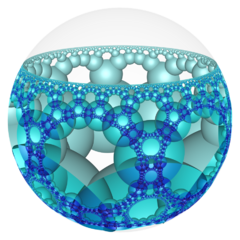 Poincaré disk model |
It has a second construction as a uniform honeycomb, Schläfli symbol {3,81,1}, Coxeter diagram,
, with alternating types or colors of order-8 triangular tiling cells. In Coxeter notation the half symmetry is [3,8,4,1+] = [3,81,1].
Order-8-5 triangular honeycomb
| Order-8-5 triangular honeycomb | |
|---|---|
| Type | Regular honeycomb |
| Schläfli symbols | {3,8,5} |
| Coxeter diagrams | Error creating thumbnail: Unable to save thumbnail to destination Error creating thumbnail: Unable to save thumbnail to destination Error creating thumbnail: Unable to save thumbnail to destination Error creating thumbnail: Unable to save thumbnail to destination Error creating thumbnail: Unable to save thumbnail to destination Error creating thumbnail: Unable to save thumbnail to destination Error creating thumbnail: Unable to save thumbnail to destination
|
| Cells | {3,8} |
| Faces | {3} |
| Edge figure | {5} |
| Vertex figure | {8,5} |
| Dual | {5,8,3} |
| Coxeter group | [3,8,5] |
| Properties | Regular |
In the geometry of hyperbolic 3-space, the order-8-3 triangular honeycomb (or 3,8,5 honeycomb) is a regular space-filling tessellation (or honeycomb) with Schläfli symbol {3,8,5}. It has five order-8 triangular tiling, {3,8}, around each edge. All vertices are ultra-ideal (existing beyond the ideal boundary) with infinitely many order-8 triangular tilings existing around each vertex in an order-5 octagonal tiling vertex figure.
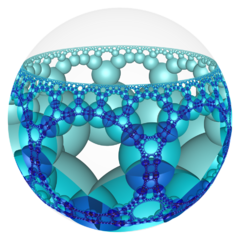 Poincaré disk model |
Order-8-6 triangular honeycomb
| Order-8-6 triangular honeycomb | |
|---|---|
| Type | Regular honeycomb |
| Schläfli symbols | {3,8,6} {3,(8,3,8)} |
| Coxeter diagrams | Error creating thumbnail: Unable to save thumbnail to destination Error creating thumbnail: Unable to save thumbnail to destination Error creating thumbnail: Unable to save thumbnail to destination Error creating thumbnail: Unable to save thumbnail to destination Error creating thumbnail: Unable to save thumbnail to destination Error creating thumbnail: Unable to save thumbnail to destination Error creating thumbnail: Unable to save thumbnail to destination Error creating thumbnail: Unable to save thumbnail to destination Error creating thumbnail: Unable to save thumbnail to destination Error creating thumbnail: Unable to save thumbnail to destination Error creating thumbnail: Unable to save thumbnail to destination Error creating thumbnail: Unable to save thumbnail to destination Error creating thumbnail: Unable to save thumbnail to destination Error creating thumbnail: Unable to save thumbnail to destination = Error creating thumbnail: Unable to save thumbnail to destination Error creating thumbnail: Unable to save thumbnail to destination Error creating thumbnail: Unable to save thumbnail to destination Error creating thumbnail: Unable to save thumbnail to destination Error creating thumbnail: Unable to save thumbnail to destination
|
| Cells | {3,8} |
| Faces | {3} |
| Edge figure | {6} |
| Vertex figure | {8,6} {(8,3,8)} |
| Dual | {6,8,3} |
| Coxeter group | [3,8,6] |
| Properties | Regular |
In the geometry of hyperbolic 3-space, the order-8-6 triangular honeycomb (or 3,8,6 honeycomb) is a regular space-filling tessellation (or honeycomb) with Schläfli symbol {3,8,6}. It has infinitely many order-8 triangular tiling, {3,8}, around each edge. All vertices are ultra-ideal (existing beyond the ideal boundary) with infinitely many order-8 triangular tilings existing around each vertex in an order-6 octagonal tiling, {8,6}, vertex figure.
 Poincaré disk model |
Order-8-infinite triangular honeycomb
| Order-8-infinite triangular honeycomb | |
|---|---|
| Type | Regular honeycomb |
| Schläfli symbols | {3,8,∞} {3,(8,∞,8)} |
| Coxeter diagrams | Error creating thumbnail: Unable to save thumbnail to destination Error creating thumbnail: Unable to save thumbnail to destination Error creating thumbnail: Unable to save thumbnail to destination Error creating thumbnail: Unable to save thumbnail to destination Error creating thumbnail: Unable to save thumbnail to destination Error creating thumbnail: Unable to save thumbnail to destination Error creating thumbnail: Unable to save thumbnail to destination Error creating thumbnail: Unable to save thumbnail to destination Error creating thumbnail: Unable to save thumbnail to destination Error creating thumbnail: Unable to save thumbnail to destination Error creating thumbnail: Unable to save thumbnail to destination Error creating thumbnail: Unable to save thumbnail to destination Error creating thumbnail: Unable to save thumbnail to destination Error creating thumbnail: Unable to save thumbnail to destination = Error creating thumbnail: Unable to save thumbnail to destination Error creating thumbnail: Unable to save thumbnail to destination Error creating thumbnail: Unable to save thumbnail to destination Error creating thumbnail: Unable to save thumbnail to destination Error creating thumbnail: Unable to save thumbnail to destination Error creating thumbnail: Unable to save thumbnail to destination
|
| Cells | {3,8} |
| Faces | {3} |
| Edge figure | {∞} |
| Vertex figure | {8,∞} {(8,∞,8)} |
| Dual | {∞,8,3} |
| Coxeter group | [∞,8,3] [3,((8,∞,8))] |
| Properties | Regular |
In the geometry of hyperbolic 3-space, the order-8-infinite triangular honeycomb (or 3,8,∞ honeycomb) is a regular space-filling tessellation (or honeycomb) with Schläfli symbol {3,8,∞}. It has infinitely many order-8 triangular tiling, {3,8}, around each edge. All vertices are ultra-ideal (existing beyond the ideal boundary) with infinitely many order-8 triangular tilings existing around each vertex in an infinite-order octagonal tiling, {8,∞}, vertex figure.
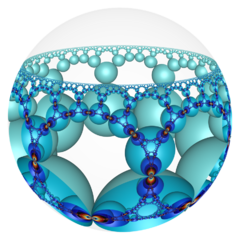 Poincaré disk model |
It has a second construction as a uniform honeycomb, Schläfli symbol {3,(8,∞,8)}, Coxeter diagram,
=
, with alternating types or colors of order-8 triangular tiling cells. In Coxeter notation the half symmetry is [3,8,∞,1+] = [3,((8,∞,8))].
Order-8-3 square honeycomb
| Order-8-3 square honeycomb | |
|---|---|
| Type | Regular honeycomb |
| Schläfli symbol | {4,8,3} |
| Coxeter diagram | Error creating thumbnail: Unable to save thumbnail to destination Error creating thumbnail: Unable to save thumbnail to destination Error creating thumbnail: Unable to save thumbnail to destination Error creating thumbnail: Unable to save thumbnail to destination Error creating thumbnail: Unable to save thumbnail to destination Error creating thumbnail: Unable to save thumbnail to destination Error creating thumbnail: Unable to save thumbnail to destination
|
| Cells | {4,8} 
|
| Faces | {4} |
| Vertex figure | {8,3} |
| Dual | {3,8,4} |
| Coxeter group | [4,8,3] |
| Properties | Regular |
In the geometry of hyperbolic 3-space, the order-8-3 square honeycomb (or 4,8,3 honeycomb) a regular space-filling tessellation (or honeycomb). Each infinite cell consists of an octagonal tiling whose vertices lie on a 2-hypercycle, each of which has a limiting circle on the ideal sphere.
The Schläfli symbol of the order-8-3 square honeycomb is {4,8,3}, with three order-4 octagonal tilings meeting at each edge. The vertex figure of this honeycomb is an octagonal tiling, {8,3}.
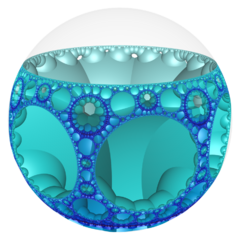 Poincaré disk model |
Order-8-3 pentagonal honeycomb
| Order-8-3 pentagonal honeycomb | |
|---|---|
| Type | Regular honeycomb |
| Schläfli symbol | {5,8,3} |
| Coxeter diagram | Error creating thumbnail: Unable to save thumbnail to destination Error creating thumbnail: Unable to save thumbnail to destination Error creating thumbnail: Unable to save thumbnail to destination Error creating thumbnail: Unable to save thumbnail to destination Error creating thumbnail: Unable to save thumbnail to destination Error creating thumbnail: Unable to save thumbnail to destination Error creating thumbnail: Unable to save thumbnail to destination
|
| Cells | {5,8} 
|
| Faces | {5} |
| Vertex figure | {8,3} |
| Dual | {3,8,5} |
| Coxeter group | [5,8,3] |
| Properties | Regular |
In the geometry of hyperbolic 3-space, the order-8-3 pentagonal honeycomb (or 5,8,3 honeycomb) a regular space-filling tessellation (or honeycomb). Each infinite cell consists of an order-8 pentagonal tiling whose vertices lie on a 2-hypercycle, each of which has a limiting circle on the ideal sphere.
The Schläfli symbol of the order-6-3 pentagonal honeycomb is {5,8,3}, with three order-8 pentagonal tilings meeting at each edge. The vertex figure of this honeycomb is an octagonal tiling, {8,3}.
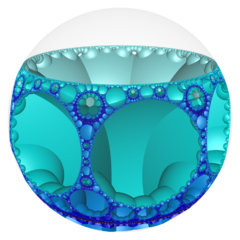 Poincaré disk model |
Order-8-3 hexagonal honeycomb
| Order-8-3 hexagonal honeycomb | |
|---|---|
| Type | Regular honeycomb |
| Schläfli symbol | {6,8,3} |
| Coxeter diagram | Error creating thumbnail: Unable to save thumbnail to destination Error creating thumbnail: Unable to save thumbnail to destination Error creating thumbnail: Unable to save thumbnail to destination Error creating thumbnail: Unable to save thumbnail to destination Error creating thumbnail: Unable to save thumbnail to destination Error creating thumbnail: Unable to save thumbnail to destination Error creating thumbnail: Unable to save thumbnail to destination
|
| Cells | {6,8} 
|
| Faces | {6} |
| Vertex figure | {8,3} |
| Dual | {3,8,6} |
| Coxeter group | [6,8,3] |
| Properties | Regular |
In the geometry of hyperbolic 3-space, the order-8-3 hexagonal honeycomb (or 6,8,3 honeycomb) a regular space-filling tessellation (or honeycomb). Each infinite cell consists of an order-6 hexagonal tiling whose vertices lie on a 2-hypercycle, each of which has a limiting circle on the ideal sphere.
The Schläfli symbol of the order-8-3 hexagonal honeycomb is {6,8,3}, with three order-5 hexagonal tilings meeting at each edge. The vertex figure of this honeycomb is an octagonal tiling, {8,3}.
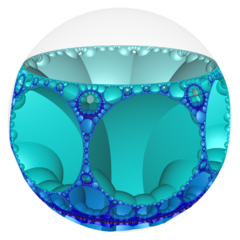 Poincaré disk model |
Order-8-3 apeirogonal honeycomb
| Order-8-3 apeirogonal honeycomb | |
|---|---|
| Type | Regular honeycomb |
| Schläfli symbol | {∞,8,3} |
| Coxeter diagram | Error creating thumbnail: Unable to save thumbnail to destination Error creating thumbnail: Unable to save thumbnail to destination Error creating thumbnail: Unable to save thumbnail to destination Error creating thumbnail: Unable to save thumbnail to destination Error creating thumbnail: Unable to save thumbnail to destination Error creating thumbnail: Unable to save thumbnail to destination Error creating thumbnail: Unable to save thumbnail to destination
|
| Cells | {∞,8} 
|
| Faces | Apeirogon {∞} |
| Vertex figure | {8,3} |
| Dual | {3,8,∞} |
| Coxeter group | [∞,8,3] |
| Properties | Regular |
In the geometry of hyperbolic 3-space, the order-8-3 apeirogonal honeycomb (or ∞,8,3 honeycomb) a regular space-filling tessellation (or honeycomb). Each infinite cell consists of an order-8 apeirogonal tiling whose vertices lie on a 2-hypercycle, each of which has a limiting circle on the ideal sphere.
The Schläfli symbol of the apeirogonal tiling honeycomb is {∞,8,3}, with three order-8 apeirogonal tilings meeting at each edge. The vertex figure of this honeycomb is an octagonal tiling, {8,3}.
The "ideal surface" projection below is a plane-at-infinity, in the Poincaré half-space model of H3. It shows an Apollonian gasket pattern of circles inside a largest circle.
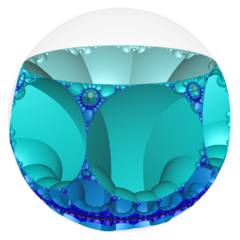 Poincaré disk model |
Order-8-4 square honeycomb
| Order-8-4 square honeycomb | |
|---|---|
| Type | Regular honeycomb |
| Schläfli symbol | {4,8,4} |
| Coxeter diagrams | Error creating thumbnail: Unable to save thumbnail to destination Error creating thumbnail: Unable to save thumbnail to destination Error creating thumbnail: Unable to save thumbnail to destination Error creating thumbnail: Unable to save thumbnail to destination Error creating thumbnail: Unable to save thumbnail to destination Error creating thumbnail: Unable to save thumbnail to destination Error creating thumbnail: Unable to save thumbnail to destination Error creating thumbnail: Unable to save thumbnail to destination Error creating thumbnail: Unable to save thumbnail to destination Error creating thumbnail: Unable to save thumbnail to destination Error creating thumbnail: Unable to save thumbnail to destination Error creating thumbnail: Unable to save thumbnail to destination Error creating thumbnail: Unable to save thumbnail to destination Error creating thumbnail: Unable to save thumbnail to destination = Error creating thumbnail: Unable to save thumbnail to destination Error creating thumbnail: Unable to save thumbnail to destination Error creating thumbnail: Unable to save thumbnail to destination Error creating thumbnail: Unable to save thumbnail to destination Error creating thumbnail: Unable to save thumbnail to destination
|
| Cells | {4,8} 
|
| Faces | {4} |
| Edge figure | {4} |
| Vertex figure | {8,4} |
| Dual | self-dual |
| Coxeter group | [4,8,4] |
| Properties | Regular |
In the geometry of hyperbolic 3-space, the order-8-4 square honeycomb (or 4,8,4 honeycomb) a regular space-filling tessellation (or honeycomb) with Schläfli symbol {4,8,4}.
All vertices are ultra-ideal (existing beyond the ideal boundary) with four order-5 square tilings existing around each edge and with an order-4 octagonal tiling vertex figure.
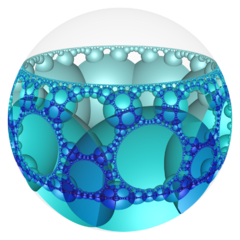 Poincaré disk model |
Order-8-5 pentagonal honeycomb
| Order-8-5 pentagonal honeycomb | |
|---|---|
| Type | Regular honeycomb |
| Schläfli symbol | {5,8,5} |
| Coxeter diagrams | Error creating thumbnail: Unable to save thumbnail to destination Error creating thumbnail: Unable to save thumbnail to destination Error creating thumbnail: Unable to save thumbnail to destination Error creating thumbnail: Unable to save thumbnail to destination Error creating thumbnail: Unable to save thumbnail to destination Error creating thumbnail: Unable to save thumbnail to destination Error creating thumbnail: Unable to save thumbnail to destination
|
| Cells | {5,8} 
|
| Faces | {5} |
| Edge figure | {5} |
| Vertex figure | {8,5} |
| Dual | self-dual |
| Coxeter group | [5,8,5] |
| Properties | Regular |
In the geometry of hyperbolic 3-space, the order-8-5 pentagonal honeycomb (or 5,8,5 honeycomb) a regular space-filling tessellation (or honeycomb) with Schläfli symbol {5,8,5}.
All vertices are ultra-ideal (existing beyond the ideal boundary) with five order-8 pentagonal tilings existing around each edge and with an order-5 pentagonal tiling vertex figure.
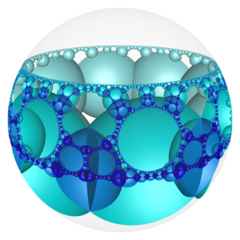 Poincaré disk model |
Order-8-6 hexagonal honeycomb
| Order-8-6 hexagonal honeycomb | |
|---|---|
| Type | Regular honeycomb |
| Schläfli symbols | {6,8,6} {6,(8,3,8)} |
| Coxeter diagrams | Error creating thumbnail: Unable to save thumbnail to destination Error creating thumbnail: Unable to save thumbnail to destination Error creating thumbnail: Unable to save thumbnail to destination Error creating thumbnail: Unable to save thumbnail to destination Error creating thumbnail: Unable to save thumbnail to destination Error creating thumbnail: Unable to save thumbnail to destination Error creating thumbnail: Unable to save thumbnail to destination Error creating thumbnail: Unable to save thumbnail to destination Error creating thumbnail: Unable to save thumbnail to destination Error creating thumbnail: Unable to save thumbnail to destination Error creating thumbnail: Unable to save thumbnail to destination Error creating thumbnail: Unable to save thumbnail to destination Error creating thumbnail: Unable to save thumbnail to destination Error creating thumbnail: Unable to save thumbnail to destination = Error creating thumbnail: Unable to save thumbnail to destination Error creating thumbnail: Unable to save thumbnail to destination Error creating thumbnail: Unable to save thumbnail to destination Error creating thumbnail: Unable to save thumbnail to destination Error creating thumbnail: Unable to save thumbnail to destination
|
| Cells | {6,8} 
|
| Faces | {6} |
| Edge figure | {6} |
| Vertex figure | {8,6} {(5,3,5)} |
| Dual | self-dual |
| Coxeter group | [6,8,6] [6,((8,3,8))] |
| Properties | Regular |
In the geometry of hyperbolic 3-space, the order-8-6 hexagonal honeycomb (or 6,8,6 honeycomb) is a regular space-filling tessellation (or honeycomb) with Schläfli symbol {6,8,6}. It has six order-8 hexagonal tilings, {6,8}, around each edge. All vertices are ultra-ideal (existing beyond the ideal boundary) with infinitely many hexagonal tilings existing around each vertex in an order-6 octagonal tiling vertex arrangement.
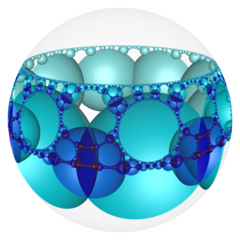 Poincaré disk model |
It has a second construction as a uniform honeycomb, Schläfli symbol {6,(8,3,8)}, Coxeter diagram,
, with alternating types or colors of cells. In Coxeter notation the half symmetry is [6,8,6,1+] = [6,((8,3,8))].
Order-8-infinite apeirogonal honeycomb
| Order-8-infinite apeirogonal honeycomb | |
|---|---|
| Type | Regular honeycomb |
| Schläfli symbols | {∞,8,∞} {∞,(8,∞,8)} |
| Coxeter diagrams | Error creating thumbnail: Unable to save thumbnail to destination Error creating thumbnail: Unable to save thumbnail to destination Error creating thumbnail: Unable to save thumbnail to destination Error creating thumbnail: Unable to save thumbnail to destination Error creating thumbnail: Unable to save thumbnail to destination Error creating thumbnail: Unable to save thumbnail to destination Error creating thumbnail: Unable to save thumbnail to destination Error creating thumbnail: Unable to save thumbnail to destination Error creating thumbnail: Unable to save thumbnail to destination Error creating thumbnail: Unable to save thumbnail to destination Error creating thumbnail: Unable to save thumbnail to destination Error creating thumbnail: Unable to save thumbnail to destination Error creating thumbnail: Unable to save thumbnail to destination Error creating thumbnail: Unable to save thumbnail to destination ↔ Error creating thumbnail: Unable to save thumbnail to destination Error creating thumbnail: Unable to save thumbnail to destination Error creating thumbnail: Unable to save thumbnail to destination Error creating thumbnail: Unable to save thumbnail to destination Error creating thumbnail: Unable to save thumbnail to destination Error creating thumbnail: Unable to save thumbnail to destination
|
| Cells | {∞,8} 
|
| Faces | {∞} |
| Edge figure | {∞} |
| Vertex figure | |
| Dual | self-dual |
| Coxeter group | [∞,8,∞] [∞,((8,∞,8))] |
| Properties | Regular |
In the geometry of hyperbolic 3-space, the order-8-infinite apeirogonal honeycomb (or ∞,8,∞ honeycomb) is a regular space-filling tessellation (or honeycomb) with Schläfli symbol {∞,8,∞}. It has infinitely many order-8 apeirogonal tiling {∞,8} around each edge. All vertices are ultra-ideal (existing beyond the ideal boundary) with infinitely many order-8 apeirogonal tilings existing around each vertex in an infinite-order octagonal tiling vertex figure.
 Poincaré disk model |
It has a second construction as a uniform honeycomb, Schläfli symbol {∞,(8,∞,8)}, Coxeter diagram,
, with alternating types or colors of cells.
See also
- Convex uniform honeycombs in hyperbolic space
- List of regular polytopes
References
- Coxeter, Regular Polytopes, 3rd. ed., Dover Publications, 1973. ISBN:0-486-61480-8. (Tables I and II: Regular polytopes and honeycombs, pp. 294–296)
- The Beauty of Geometry: Twelve Essays (1999), Dover Publications, LCCN 99-35678, ISBN:0-486-40919-8 (Chapter 10, Regular Honeycombs in Hyperbolic Space) Table III
- Jeffrey R. Weeks The Shape of Space, 2nd edition ISBN:0-8247-0709-5 (Chapters 16–17: Geometries on Three-manifolds I, II)
- George Maxwell, Sphere Packings and Hyperbolic Reflection Groups, JOURNAL OF ALGEBRA 79,78-97 (1982) [1]
- Hao Chen, Jean-Philippe Labbé, Lorentzian Coxeter groups and Boyd-Maxwell ball packings, (2013)[2]
- Visualizing Hyperbolic Honeycombs arXiv:1511.02851 Roice Nelson, Henry Segerman (2015)
External links
- Hyperbolic Catacombs Carousel: {3,7,3} honeycomb YouTube, Roice Nelson
- John Baez, Visual insights: {7,3,3} Honeycomb (2014/08/01) {7,3,3} Honeycomb Meets Plane at Infinity (2014/08/14)
- Danny Calegari, Kleinian, a tool for visualizing Kleinian groups, Geometry and the Imagination 4 March 2014. [3]
 |

